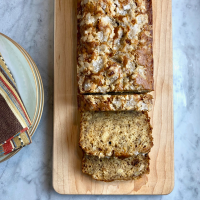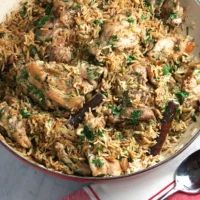I was initially drawn to this recipe because of the “jewel-like” color of the salmon in the finished dish. The beet and dill marinade gives it the lovely color as well as a wonderful layer of flavor. My husband was completely sold when I told him that the salmon is roasted over a bed of sliced potatoes. 🙂
I served this dish on Easter weekend, on Easter Eve, along with zucchini baba ghanoush as an appetizer and carrot cake for dessert. I would serve this menu again next year and serve it on Easter Eve- it was nice to have our larger and more labor-intensive meal the night before all of the Easter festivities. We had a spring pasta dish for lunch on Easter after having challah and Easter eggs (and Easter candy!) for breakfast. Perfect.
This lovely recipe was adapted from Martha Stewart Living. I decreased the horseradish and left the skin on the potatoes. I also used a mandoline to slice the potatoes. I served it with steamed beet greens, roasted beets, and roasted asparagus on the side. Healthy and delicious.
- 1 small red beet, peeled and coarsely grated (1/2 cup)(wear gloves!)
- 1 cup dill fronds, chopped, plus more for serving
- 3 to 4 T freshly grated horseradish (from a 2-inch piece), or 2 tablespoons prepared horseradish
- grated zest of 1 lemon, plus lemon half for serving
- 1/4 cup extra-virgin olive oil, plus more for drizzling
- 1 side salmon, preferably wild, (1 3/4 to 2 pounds; about 1 inch thick at thickest part), skin removed
- coarse salt and freshly ground black pepper
- 2 pounds Yukon Gold potatoes, cut into 1/4-inch slices (preferably with a mandoline)
- Combine beet, dill, horseradish, zest, and 2 tablespoons oil in a bowl.
- Line a rimmed baking sheet with parchment. Season both sides of salmon generously with salt and pepper; transfer to sheet. Spread beet mixture on top. Let stand 30 minutes.
- Meanwhile, preheat oven to 425 degrees. Toss potatoes with remaining 2 tablespoons oil; season generously with salt and pepper.
- Shingle potatoes in a 9-by-13-inch baking dish, in a single layer. Bake until tender, about 35 minutes; remove from oven.
- Remove beet mixture from top of salmon with a spoon; spread over center of potatoes.
- Top beet mixture with fish (you may need to tuck part of tail end under fish to fit in pan), drizzle with oil (I omitted the additional oil), and bake until salmon is medium-rare, 10 to 12 minutes.
- Squeeze with lemon, garnish with dill fronds, and serve.
Note: Cooking time will vary depending on the thickness of the fish. For salmon that is 1/2 inch thick, start checking at 8 minutes. For 1 1/2 inches, start checking around 14 minutes.
One Year Ago: Swedish Meatloaf with Caramelized Cabbage (Kalpudding)
Two Years Ago: Chicken Paprikash
Three Years Ago: Pork & Ricotta Meatballs in Parmesan Broth
Four Years Ago: Pork Chops with Shiitake Mushrooms & Mustard Vinaigrette
Five Years Ago: Italian Braised Pork

















